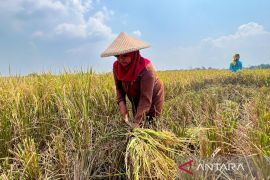Data recorded by BPS has shown that rice prices experienced an inflation of 1.13 percent in October 2022 and contributed 0.34 percent to national inflation.
According to data from the National Food Agency's (NFA) Food Price Panel, the price of medium-quality rice at the consumer level stood at Rp11,090 per kilogram in October and rose to Rp11,160 per kilogram as of November 27.
Rice prices increased 4.3 percent from Rp10,700 per kilogram in the period from July to November.
Rice has become the food commodity with the greatest contribution to inflation because it is a basic food that is consumed by almost all people in the country.
Head of the NFA, Arief Prasetyo Adi, attributed the increase in rice prices to an increase in the cost of production at the farm level due to rising fuel and fertilizer prices.
In addition, the weather has also contributed to a decline in national rice production, with several regions, such as West Java, Central Java, and Lampung, experiencing crop failures due to the flooding of paddy fields.
One of the tasks and functions of the State Logistics Agency (Bulog) is to control the price of rice in the market and ensure that it does not skyrocket by intervening through the Supply Availability and Price Stabilization (KPSH) program or market operations.
Bulog provides rice at a price lower than the market price and increases the supply of rice in the market. In accordance with economic principles, when there is excess supply compared to demand, prices fall.
However, the problem that Bulog is currently facing concerns rice stocks, which are starting to run low from month to month. As per the NFA, Bulog must maintain rice stocks of at least 1.2 million for the KPSH program or market operations and emergency needs, such as natural disasters or social assistance.
As of November 16, Bulog’s total rice stocks, both government rice reserves (CBP) of medium quality and commercial rice of premium quality, stood at 651 thousand tons. The stocks declined to 594 thousand tons as of November 23, comprising 426,573 tons of CBP and 168,283 tons of commercial rice.
The stocks may further deplete to 300 thousand tons because Bulog is still continuing its market operations every month by releasing around 120 thousand to 150 thousand tons of rice per month.
Bulog president director Budi Waseso said that his agency is currently still absorbing domestically produced rice from a number of mills, but the volume is not much.
The agency said that currently, there are no more harvests being carried out by farmers as they are still in the waiting period between harvests. Therefore, Bulog cannot buy paddy directly from farmers.
Based on data from the Directorate General of Food Crops of the Ministry of Agriculture, stocks of 1.8 million tons of rice are available in mills across Indonesia. However, Bulog cannot buy them because the millers need to maintain supply for their own market share.
Thus, Bulog will not be able to obtain 1.2 million tons of rice stocks until the end of 2022 if it depends on domestic rice production. The last option that the agency can exercise is importing rice, even though that would break Indonesia's record of no rice imports for three consecutive years, as noted by the International Rice Research Institute (IRRI) and the Food and Agriculture Organization (FAO).
Supporting local farmers
Bulog is 100-percent committed to siding with local farmers, hence, the option of importing rice will not be exercised if domestic stocks are available.
Waseso has demonstrated his support for local farmers: under his leadership, Bulog has not imported rice to meet the needs of CBP for the past four years.
In fact, the rice imports assigned to Bulog during the main harvest in early 2021 were not carried out by Waseso because the absorption of domestic rice production was sufficient to meet the agency’s needs for replenishing stocks.
Thus, he expressed the hope that the current decision to import rice will not be viewed as Bulog not siding with local farmers.
Bulog has purchased 500 thousand tons of commercial rice from abroad to fill stocks because, if it does not strengthen rice reserve stocks, the price of rice may soar.
If the price of rice continues to soar, then food inflation could occur and consequently, impact national inflation. This could lead to a decrease in people's purchasing power and limit access to staple foods, which could then spread to socioeconomic aspects.
In general, rice stocks in Indonesia are still safe until the end of 2022. Data from the Agriculture Ministry has pegged Indonesia's rice stocks at 8.05 million tons. Of the total, 1,868,414 tons are with mills, 831,805 tons are with rice traders, and the rest are with households.
Related news: NFA urges rice millers to prioritize sales to Bulog
Related news: Perpadi's role crucial for increasing rice reserve stocks: NFA
Related news: Rice stock sufficient to meet demand till year-end: Bulog
Translator: Aditya Ramadhan, Raka Adji
Editor: Azis Kurmala
Copyright © ANTARA 2022












